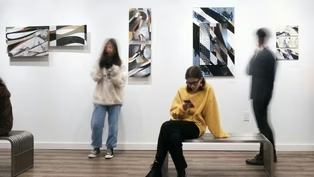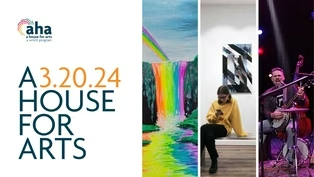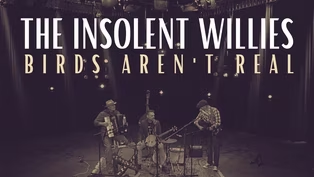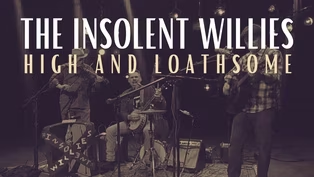
Art Without Borders: Inside Paint Cohoes with Alicia Lea
Clip: Season 9 Episode 16 | 9m 46sVideo has Closed Captions
Explore the transformative journey of artist Alicia Lea.
Explore the transformative journey of artist Alicia Lea, from graffiti to owning Paint Cohoes, a vibrant art studio fostering creativity and community.
Problems playing video? | Closed Captioning Feedback
Problems playing video? | Closed Captioning Feedback
AHA! A House for Arts is a local public television program presented by WMHT
Support provided by the New York State Council on the Arts (NYSCA), M&T Bank, the Leo Cox Beach Philanthropic Foundation, and is also provided by contributors to the WMHT Venture...

Art Without Borders: Inside Paint Cohoes with Alicia Lea
Clip: Season 9 Episode 16 | 9m 46sVideo has Closed Captions
Explore the transformative journey of artist Alicia Lea, from graffiti to owning Paint Cohoes, a vibrant art studio fostering creativity and community.
Problems playing video? | Closed Captioning Feedback
How to Watch AHA! A House for Arts
AHA! A House for Arts is available to stream on pbs.org and the free PBS App, available on iPhone, Apple TV, Android TV, Android smartphones, Amazon Fire TV, Amazon Fire Tablet, Roku, Samsung Smart TV, and Vizio.
Providing Support for PBS.org
Learn Moreabout PBS online sponsorship- Welcome Alicia.
Welcome to "A House for Arts" today.
- Hello, how are you?
- I'm doing amazing.
I'm excited to talk to you all things art, and a little bit about Paint Cohoes.
But to begin, I would love to know what are your artistic focuses and what's your favorite medium?
- So I love to play in all mediums.
I don't shy away from anything.
I love getting my hands messy and dirty.
I love exploring new mediums, but my favorite is aerosol.
I love playing with spray paint.
So much fun.
- Spray paint, okay, so what's your favorite?
So as a person who also loves spray paint and graffiti, so what are some of your favorite things about spray paint?
- So I love how quick and easy you can get paint on a wall.
That's pretty amazing.
I love the aesthetic-ness of it.
I love how unconventional the tool is to use in art.
And I do have a little bit of a background in graffiti.
- Give us a little bit about your background.
- I was in school for art and I was looking for a sense of community within the arts because I was a little unconventional and I'm very unapologetically myself, and sometimes I can be deemed as too much for people, right?
So first of all, graffiti is art that can be seen and accessible to everybody, and also against societal norms or what's socially acceptable.
So I already felt like I didn't fit in.
It felt as an art form that I was able to express myself wholly in.
And also painting with other graffiti artists, it didn't matter if I was good at letters or not.
Like they were just happy to have me be a part of the group and to grow with them and to evolve with them as I was learning the art of graffiti.
- Yeah, I will say that the street art and more urban graffiti art world is pretty accepting.
And all just like a band of misfits.
You all just wanna explore and succeed creatively together.
So what were some differences that you saw in the graffiti world versus kind of the fine arts world since you kind of dipped your toes in both?
- Yeah, so the really cool thing about the graffiti world is that you get a sense of community.
You're growing together, you're going out, you're getting that endorphin rush, and then you're creating accessible art, and you're also creating a network within other cities.
So I'm traveling, right?
And I'm meeting other artists and I'm networking in a more acceptable way for me.
Whereas the fine arts almost was like a prove yourself sort of deal.
I come in with a lot of energy and I just didn't fit in.
I'm not saying the pretentious attitude bleeds into all the capital region because shout out to Tony Iadicicco from Albany Center Gallery.
- Tony!
- I love Tony.
He's amazing.
And he has helped me as an artist so much.
I would not be where I am today if Tony had not helped me out.
So I just shout out to Tony there real quick.
But I did notice a lot of other pretentiousness in other spaces where they weren't accepting of new ideas or new types of art or just pushing the limits of what it was like as contemporary art in the capital region.
But I'm noticing a difference now, which is really great.
- Yes, there is a shift changing within the capital region, which I am also witnessing and I love to see it.
So you're saying like more in the graffiti world, the street art world, it was just more accepting.
- It was, yeah.
You didn't have to be, like there's obviously an ego that comes into the graffiti world, but when you're within a crew, they become like your family.
I was homeless at one point and I was putting myself through college while I was working, and that was really hard.
And not having that support system from family because they're going through their own things at that time and they weren't able to be there for me.
I don't judge or blame anybody for the position I put myself in.
I wanted to go to school.
So inevitably I had to do certain things to be able to go, and I was able to create a family of likeness through graffiti with them.
- That's awesome.
That's awesome.
Really beautiful story too.
So let's talk a little bit about Paint Cohoes.
So what is, and how did it get started?
- All right, so Paint Cohoes is a studio and gallery, studio because we offer an array of classes and space for people to come create in.
It is a working studio for myself.
I like to create in there.
We are also a gallery because we exhibit local and non-local artists.
And we do not discriminate on where you are in your path as an artist.
We want everyone to feel safe and comfortable to be able to creatively express themselves within the space.
So a little bit about how I always wanted to have a space, I've craved a space like that.
And I didn't have anything in the capital region that I could go to.
So I'm the kind of person where I'm like, I'm more of a, what am I gonna do next?
Let's do it sort of situation, but also I gotta be smart about it, right?
Because I need to create revenue to keep the space going.
And I kind of always took jobs besides my time at Starbucks where I could take my skillsets and apply it to like my higher purpose, which I felt deep inside my soul.
So I always wanted to have a place, a creative space.
And I have an educational background.
I've worked with children since, I mean babysat all through high school, I taught early childhood education from 18 years old up until 26 I think.
I still work with children, but I got out of, this is the schools, and started working with not-for-profits and working at my space doing classes and stuff.
- Awesome, well I love that paint, and it does exist actually in Cohoes, correct?
- Right on Remsen Street.
- Just wanna make sure.
How did the name come to be?
- So the idea was potentially, because I like to think like, I'm like, oh here's an idea.
I always think outside of that, like how can this expand and grow?
And I thought the idea of maybe not necessarily franchising, but like an idea of being able to franchise the business and bring other cities and other places and have a model or a setup that other people can adopt to make the arts more accessible within their communities while creating revenue.
- So like Paint Albany, Paint Troy, Paint Cohoes?
- Yeah, Paint LA.
- Oh my God.
Outside here too.
- Because sometimes as an artist it's hard to have the confidence to be able to effectively create revenue and to be actively involved within your community, in your creative community.
- Do you ever, I guess, have any conflicting feelings about, as an artist, like focusing on the revenue business side?
Some artists are kind of stuck in the middle.
Some artists are like, oh, I would never, you know, I don't even care, I would never create for anybody but myself.
And then you have some artists who are like, yeah, like art should be able to be a business and you should be able to monetize off of your work because that's how we're living.
- Absolutely.
That's like any profession, right?
We should be able to.
A lot of my strongest feelings that were a little bit more, my most negative feelings were towards the Sip 'N Paint industry, which is funny because a lot of people know me as a Sip 'N Paint lady, which is hilarious.
But at first, I had worked at a Sip 'N Paint up in Latham, and while working there, I had learned the importance of teaching people how to create that never created before.
So I was able to create a comfortable environment for them to feel safe and happy and to explore something that they haven't done since they were a child.
And to see their eyes light up, how proud of the work they were creating.
And then they have a new appreciation for the arts and artists, which was amazing to me.
And I'm like, oh, there's something here, you know?
And to make revenue off of that as well.
So it's like I'm supporting myself while doing good for people within the community.
- Yeah, that's great.
So what are some events and things you have done in the past with Paint Cohoes, just to paint, paint a picture for folks to know, like if they were to go in there, what would they walk into?
- So typical Sip 'N Paints, where you come in, step by step instructions to paint the painting that I'm painting.
I also work with children, do a lot of children's parties.
I also do an afterschool program where we learn the seven elements of art.
It's a 12 week program, which is amazing.
We also do Drag N' Paint where we work with local drag artists, which is amazing.
They get to creatively express themselves.
We've had people do zine release and book release parties of illustrations they have, art and healing where we do intuitive painting.
And it's led by guided meditation.
And then we get into the painting portion of it, which is really nice.
So we have sound healing at the space.
We also offer yoga.
We have had people come in and do experimental music, which is really exciting.
- Oh wow.
So you guys do a plethora of things there.
And it seems like all these things are very intentionally communal driven.
So why is it important for spaces like Paint Cohoes to exist with that inclusive safe space feeling that you seemed, because it seems like you loved that when you were in the graffiti world, it seems like it's kind of reflective within your business, Paint Cohoes.
- So I think it's extremely important for people to feel safe and comfortable so they can authentically, unapologetically, creatively express themselves without expectation or for any particular purpose or reason and no judgment.
So by having a space like that and having people be able to come in and fully be who they are creatively allows them to grow, and then the space grows with them, and then they grow out of the space and then this, you know what I mean?
There's so much movement happening, and I think that if people have safe spaces to start in or to move into the next chapter of their life and to expand upon, that's lasting, that lasts outside of the space, which is amazing.
- It really does.
And that kind of circles back to Tony, like how he created a safe space for both you and I and now look at us.
We're just flourishing within the creative economy and community.
Well I appreciate you, Alicia, and thank you for telling us about Paint Cohoes and all your creative endeavors.
- Thank you, Jade.
- Thank you.
Abstract Realities: Exploring Digital Art with Drea LaRose
Video has Closed Captions
Clip: S9 Ep16 | 6m 19s | Discover the captivating world of digital art with Drea LaRose. (6m 19s)
Drea LaRose, Alicia Phillips & The Insolent Willies: Preview
Video has Closed Captions
Preview: S9 Ep16 | 30s | Discover the transformative artistry of Drea LaRose, Paint Cohoes & The Insolent Willies. (30s)
The Insolent Willies Perform "Birds Aren't Real"
Video has Closed Captions
Clip: S9 Ep16 | 3m 54s | Join The Insolent Willies in a riveting performance of "Birds Aren't Real". (3m 54s)
The Insolent Willies Perform "High And Loathsome"
Video has Closed Captions
Clip: S9 Ep16 | 3m 44s | Join The Insolent Willies in a riveting performance of "High And Loathsome". (3m 44s)
Providing Support for PBS.org
Learn Moreabout PBS online sponsorshipSupport for PBS provided by:
AHA! A House for Arts is a local public television program presented by WMHT
Support provided by the New York State Council on the Arts (NYSCA), M&T Bank, the Leo Cox Beach Philanthropic Foundation, and is also provided by contributors to the WMHT Venture...



















